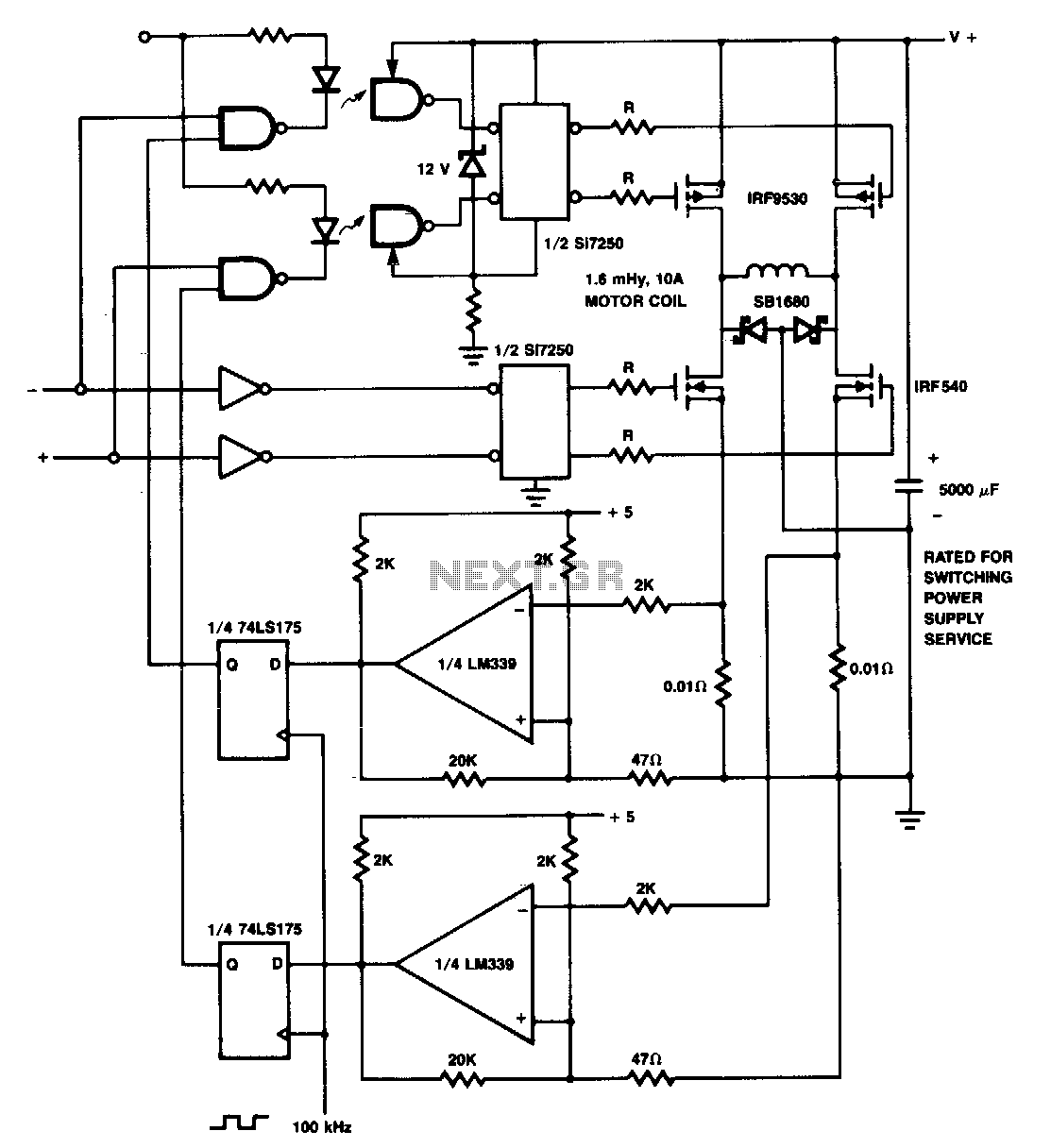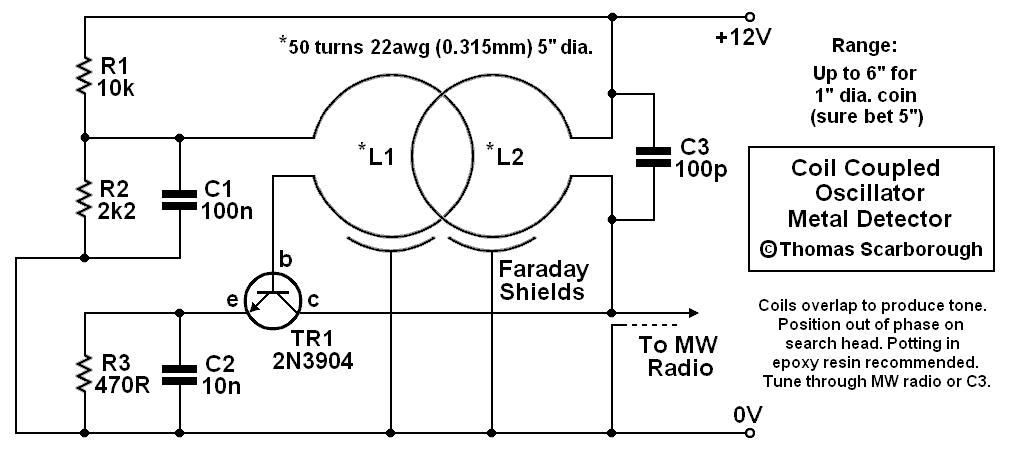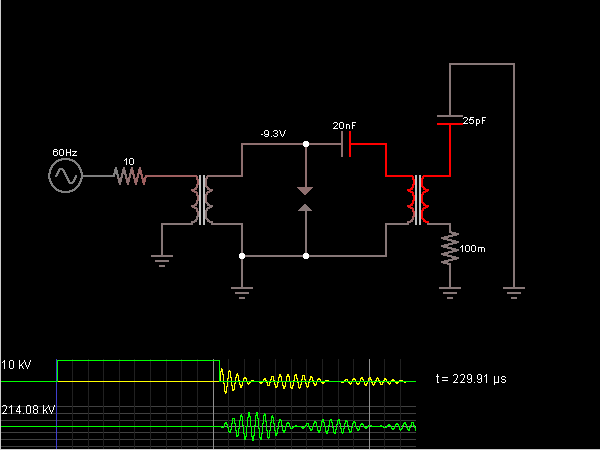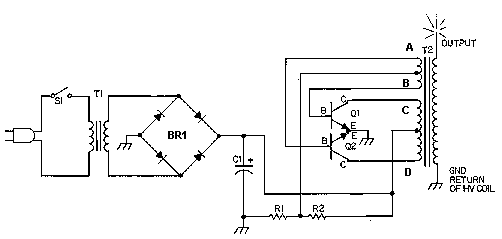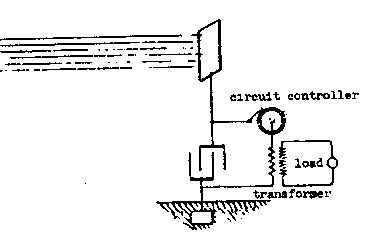
Tesla HV Coil
Warning: Undefined array key "extension" in /var/www/html/nextgr/view-circuit.php on line 477
Deprecated: strtolower(): Passing null to parameter #1 ($string) of type string is deprecated in /var/www/html/nextgr/view-circuit.php on line 477
When operated through a spark gap, does a Tesla coil always operate at a quarter wave, half wave, or a multiple of a whole wave, resulting in 2*n maximums? Are there sources related to creating standing waves and the resonance frequency of coils? The secondary coil only has a load applied. The main point is that in a Tesla coil configuration, to achieve points of maximum excitation at the ends of the coil, the excitation frequency (f) and the speed of impulse propagation (c) determine the coil's length. The number of turns is less significant than the length. The impulse travels from the beginning of the coil and back. Therefore, a higher frequency results in a shorter coil. A Tesla secondary coil should utilize a length of wire equal to a quarter-wavelength of the excitation frequency. The number of turns influences the choice between a short-fat form or a tall-skinny form. Significant energy can be stored in inter-turn capacitance. In a short-fat coil, there is a greater voltage difference between adjacent windings compared to a tall-skinny coil. Short-fat coils are more effective for maximum power transfer between the primary and secondary coils, while tall-skinny coils are better for transmitting power over distances, as seen in small Tesla power plants. This specific power plant draws only a few watts (approximately 35) from the mains, yet it can illuminate numerous fluorescent bulbs when placed nearby. Increasing the power by adjusting the spark gap (now nearly fully closed) proportionally increases the range.
The operation of a Tesla coil through a spark gap involves the generation of high-voltage, high-frequency oscillations, which are critical for establishing standing waves within the coil. The fundamental frequency at which the coil resonates is determined by its physical dimensions, specifically the length of the wire used. For optimal performance, the length of the secondary coil should correspond to a quarter wavelength of the excitation frequency. This relationship is essential for maximizing the efficiency of energy transfer and achieving the desired electrical characteristics.
In Tesla coil design, the aspect ratio of the coil—whether short and fat or tall and skinny—affects the coil's performance. Short-fat coils, which have a larger diameter, tend to store more energy in the inter-turn capacitance, leading to higher voltage differences between adjacent turns. This configuration is advantageous for maximizing power transfer between the primary and secondary coils, making it suitable for applications that require efficient energy transfer.
Conversely, tall-skinny coils are designed for applications that involve the transmission of power over distances. They are more effective in creating an electric field that can propagate energy through the air, which is particularly useful in demonstrations of wireless power transmission. In small Tesla power plants, such as the one described, the coil can draw minimal power from the mains while still being capable of lighting multiple fluorescent bulbs at a distance. This illustrates the effectiveness of the Tesla coil design in harnessing and transmitting electrical energy in a wireless format.
The adjustment of the spark gap is a critical factor in controlling the output of the Tesla coil. By varying the gap, the operator can manipulate the frequency and amplitude of the oscillations, thus affecting the overall performance and range of the coil. As the gap is opened, the energy output increases, allowing for greater distances of wireless power transmission. This principle underlies many practical applications of Tesla coils in both experimental and educational settings, where the demonstration of electrical phenomena is desired.Is it (when operated through a spark gap) allways a quarter wave, or a half wave or multiple of a whole wave so that there are 2* n maximums that are achieved. Can someone point out to sources that are related to creating standing waves and the resonance frequency of the coils.
On the secondary is only a load put on. What I wanted to say was that if it is a Tesla coil configuration and you want the points of max excitations on the ends of the coil(tesla coil) the excitation f and the speed of the propagation of impuses c determines the lenght of the coil. The no of turns is not important, the lenght is. The impulse travels from the beginning of the coil - wire and back. So the higher the f the shorter a coil. A Tesla secondary should use a length of wire that is equal to a quarter-wavelength of the excitation frequency.
The number of turns comes into play when deciding whether to use a short-fat form, or a tall-skinny form. Substantial energy can be stored in inter-turn capacitance. In a short fat coil, there is more voltage difference between adjacent windings than there is in a tall skinny coil.
Short fat coils work better for maximum power transfer between primary and secondary. Tall skinny coils work better for transmitting power across space, as in this small Tesla power plant. This power plant is drawing only a few Watts (35 or so here) from the mains, and yet it will light up as many fluorescent bulbs as you can hold near it.
Turn up the power (by opening the gap, bottom right, now nearly completely closed) and the range increases proportionally. 🔗 External reference
The operation of a Tesla coil through a spark gap involves the generation of high-voltage, high-frequency oscillations, which are critical for establishing standing waves within the coil. The fundamental frequency at which the coil resonates is determined by its physical dimensions, specifically the length of the wire used. For optimal performance, the length of the secondary coil should correspond to a quarter wavelength of the excitation frequency. This relationship is essential for maximizing the efficiency of energy transfer and achieving the desired electrical characteristics.
In Tesla coil design, the aspect ratio of the coil—whether short and fat or tall and skinny—affects the coil's performance. Short-fat coils, which have a larger diameter, tend to store more energy in the inter-turn capacitance, leading to higher voltage differences between adjacent turns. This configuration is advantageous for maximizing power transfer between the primary and secondary coils, making it suitable for applications that require efficient energy transfer.
Conversely, tall-skinny coils are designed for applications that involve the transmission of power over distances. They are more effective in creating an electric field that can propagate energy through the air, which is particularly useful in demonstrations of wireless power transmission. In small Tesla power plants, such as the one described, the coil can draw minimal power from the mains while still being capable of lighting multiple fluorescent bulbs at a distance. This illustrates the effectiveness of the Tesla coil design in harnessing and transmitting electrical energy in a wireless format.
The adjustment of the spark gap is a critical factor in controlling the output of the Tesla coil. By varying the gap, the operator can manipulate the frequency and amplitude of the oscillations, thus affecting the overall performance and range of the coil. As the gap is opened, the energy output increases, allowing for greater distances of wireless power transmission. This principle underlies many practical applications of Tesla coils in both experimental and educational settings, where the demonstration of electrical phenomena is desired.Is it (when operated through a spark gap) allways a quarter wave, or a half wave or multiple of a whole wave so that there are 2* n maximums that are achieved. Can someone point out to sources that are related to creating standing waves and the resonance frequency of the coils.
On the secondary is only a load put on. What I wanted to say was that if it is a Tesla coil configuration and you want the points of max excitations on the ends of the coil(tesla coil) the excitation f and the speed of the propagation of impuses c determines the lenght of the coil. The no of turns is not important, the lenght is. The impulse travels from the beginning of the coil - wire and back. So the higher the f the shorter a coil. A Tesla secondary should use a length of wire that is equal to a quarter-wavelength of the excitation frequency.
The number of turns comes into play when deciding whether to use a short-fat form, or a tall-skinny form. Substantial energy can be stored in inter-turn capacitance. In a short fat coil, there is more voltage difference between adjacent windings than there is in a tall skinny coil.
Short fat coils work better for maximum power transfer between primary and secondary. Tall skinny coils work better for transmitting power across space, as in this small Tesla power plant. This power plant is drawing only a few Watts (35 or so here) from the mains, and yet it will light up as many fluorescent bulbs as you can hold near it.
Turn up the power (by opening the gap, bottom right, now nearly completely closed) and the range increases proportionally. 🔗 External reference
